| City Loop | |
|---|---|
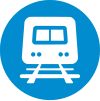 | |
 Platform at Melbourne Central station in the Platform at Melbourne Central station in the City Loop, June 2024 | |
| Overview | |
| Owner | VicTrack |
| Stations | 3 |
| Service | |
| Services | All suburban lines except Frankston, Sandringham, Werribee and Williamstown line trains |
| Operator(s) | Victorian Railways (1981–1983) Metropolitan Transit Authority (1983–1989) Public Transport Corporation (1989–1997) Bayside Trains (1997–2004) Hillside Trains (1997–2009) Metro Trains Melbourne (2009–present) |
| History | |
| Commenced | 1971 |
| Opened | 1981 |
| Completed | 1985 |
| Technical | |
| Number of tracks | 2 single bidirectional tunnels Flinders Street – Parliament 4 single bidirectional tunnels Parliament – Flagstaff 3 single bidirectional tunnels Flagstaff – Southern Cross |
| Character | Underground |
| Electrification | 1,500 V DC overhead catenary |
The City Loop (originally called the Melbourne Underground Rail Loop or MURL) is a piece of underground commuter rail infrastructure in the central business district (CBD) of Melbourne, Victoria, Australia.
The loop includes three underground stations: Flagstaff, Melbourne Central (formerly Museum) and Parliament. The loop connects to Melbourne's two busiest stations, Flinders Street and Southern Cross, and together with the Flinders Street Viaduct forms a ring of four individual tracks around the CBD.
Eleven metropolitan lines of the Melbourne rail network run through the City Loop, organised into four separate groups, the Burnley/City Circle, Caulfield, Clifton Hill, and Northern groups. Each group has its own dedicated single-track tunnel, with trains running on balloon loops around the CBD. The Loop follows La Trobe and Spring Streets along the northern and eastern edges of the CBD's street grid.
Although concepts for an underground railway had been raised since the 1920s, planning was not seriously progressed until the 1960s. The 1970 Melbourne Underground Rail Loop Act finalised the design and established an authority to oversee construction of the project. Tunnelling works began in 1972 and the Loop commenced operation in 1981 with the opening of Museum station, now Melbourne Central. The loop was fully complete in 1985 with the opening of Flagstaff station.
A new CBD rail tunnel, the Metro Tunnel, is currently under construction to relieve pressure on the City Loop, and when it opens in 2025 will see the Pakenham, Cranbourne and Sunbury metropolitan lines removed from the loop.
History
Before the City Loop was constructed, Flinders Street and Spencer Street (now called Southern Cross) stations were connected only by the four track Flinders Street Viaduct beside the Yarra River. The suburban terminus of Flinders Street had become seriously congested by the 1970s, with a throughput of only ten trains per platform per hour (roughly 1,700 trains a day) — compared to a maximum of 24 if there was through running. Many trains were through routed from the southern and eastern suburbs to the north and west, but the flow was imbalanced and a number of trains were required to reverse their direction. The Epping and Hurstbridge lines stood alone from the rest of the network, having Princes Bridge station for their own exclusive use.
Several plans had been proposed over the preceding decades to alleviate the bottleneck. The one that was adopted was the building of a circular railway allowing trains to continue past Flinders Street, loop around and return to the suburbs. It was expected to boost platform capacity, allowing more trains per platform per hour on the same number of Flinders Street platforms. The loop would also bring train commuters directly into the northern and eastern sections of the CBD, delivering workers closer to their offices, students closer to RMIT University, and government officials directly to the Parliament buildings. Although the city's tram network already covered the CBD extensively, trams are not as efficient as trains when bringing large numbers of commuters into the city.
Planning
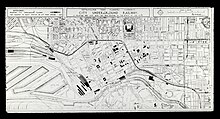
Plans for an underground city railway in Melbourne are almost as old as electrification of the network itself. In 1929, the Metropolitan Town Planning Commission released a report recommending an underground city bypass from Richmond to North Melbourne stations via Exhibition and Victoria streets. The 1940 Victorian Railways Ashworth Improvement Plan recommended a different approach, with additional platforms at the Flinders Street/Princes Bridge station complex to be built over two levels, along with a connection to an underground City Railway. The Victorian Railways promoted another route in 1950 as part of the Operation Phoenix rehabilitation plan, the line running from Richmond towards Jolimont station, under the Fitzroy Gardens and Lonsdale Street then turning north to North Melbourne station. A branch line turned north from William Street, and went through the Flagstaff Gardens. In 1954 the Melbourne & Metropolitan Board of Works released their Planning Scheme for Melbourne report, which included the Richmond – North Melbourne Lonsdale Street route.
A Parliamentary Committee on Public Works reported favourably on a city loop in 1954, and in 1958 a City Underground Railway Committee was appointed by the Transport Minister. It stated bluntly that the aim of the loop was not just to relieve crowding at Flinders Street, but to win back patronage from private cars, and if it did not then the project was a waste of time and resources. The plan included four stations, being cut to the present three by the elimination of one under Latrobe Street.
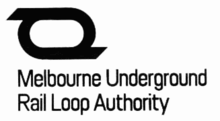
The 'City of Melbourne Underground Railway Construction Act' was passed in 1960, and test bores were sunk by the Mines Department in 1961, but no funding was provided. Throughout the next few years many proposals were made for providing more car parking in the city, so in 1963 the Government set up the Metropolitan Transportation Committee to look at both road and rail transport. It released a report in 1965 that included the same rail plan as the 1960 Act.
Construction

Following the 1969 Melbourne Transportation Plan, the Melbourne Underground Rail Loop Act 1970 was introduced into parliament by Transport Minister Vernon Wilcox, and the Melbourne Underground Rail Loop Authority (MURLA) was created on 1 January 1971 to oversee the construction and operation of the loop. The City of Melbourne, the Melbourne & Metropolitan Board of Works and the Victorian Railways all made annual contributions to support the operating costs of the authority. An unsuccessful request for funding was made to the Federal Government.
The project was financed using debentures, with the State Government paying 60% of the cost and a special city levy from 1963 funding the remainder. The levy was supposed to be in place for forty years (until 2003), but was ended in 1995. A consortium of four engineering companies was established to construct the project: one from Australia, one from the United Kingdom, one from Canada and one from the United States of America. On 22 June 1971, the first sod of the project was turned by Wilcox in the middle of the Jolimont rail yards.
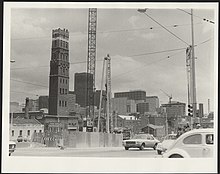
Tunnelling works under the city streets commenced in June 1972, using a tunnel boring machine built by Richmond engineering firm Jaques Limited. as well as conventional boring methods. At North Melbourne, Spencer Street and Jolimont Yard, cut and cover tunnelling was used to build the access ramps, with the above ground running lines being slewed from time to time as work proceeded. The first completed tunnel was the Burnley Loop, with the final breakthrough made on 8 June 1977 near the Museum station site.
The loop comprises four single-track tunnels on two levels, and includes +four pre-existing elevated tracks between Flinders Street and Spencer Street stations. A new double track concrete viaduct was erected beside the existing quadruple track Flinders Street Viaduct in order to replace capacity for non-loop trains. Construction began in 1975 and was completed in 1978. Of the three new stations, Museum was built using the cut and cover method in a 26-metre-deep (85 ft 4 in) box, while Flagstaff and Parliament were excavated using mining methods. During the excavation of Museum station, La Trobe Street and its tram tracks were temporarily relocated to the south onto the site of what is now the Melbourne Central Shopping Centre from December 1973, and were moved back in 1978.
The total length of tunnels in the loop is 12 km (7.5 mi) with 10 km (6.2 mi) of circular tunnels, and 2 km (1.2 mi) of box tunnels. The four tunnels have an average length of 3.74 km (2.32 mi), with a further 1 kilometre (0.62 mi) of track connecting with surface tracks. Some 900,000 m (1,177,156 cu yd) of earth was removed and 300,000 m (392,385 cu yd) of concrete poured to form the stations and line the tunnel walls.

A "double sleeper" floating track system was used to solve the problem of ground-transmitted vibration and track noise, and the loop has some of the best-designed and quietest underground stations in the world. At the time of its construction, Parliament station had the Southern Hemisphere's longest escalators.
Traction power was turned on in October 1980, and the first test train ran on 4 December 1980. In 1965, the cost of the project had been estimated at between £30 and £35 million but, by 1975, inflation had resulted in it rising to $255,600,000. While the final cost was $500 million, the opening of the loop helped reverse a 30-year trend of falling suburban rail patronage.
Opening
Queen Elizabeth II toured Museum station during her visit to Australia in May 1980, and opened the plaza on top of the Swanston Street entrance, which was named Queen Elizabeth Plaza. Two short documentary films, Loop and Action Loop, were commissioned by the MURLA to advertise the new railway to Melburnians, as well as abroad. A third film was planned, but never shot.
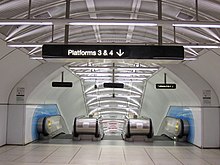
The loop was opened gradually between 1981 and 1985. Museum station and the Burnley and Caulfield tunnels opened first, on 24 January 1981. The City Circle tunnel opened with special services on 6 December 1981, and Clifton Hill services started using the loop on 31 October 1982. Parliament station opened on 22 January 1983, the Northern tunnel on 7 January 1985 (14 January 1985 with limited services) and Flagstaff station on 27 May 1985.
Recent
In 2021, seven-car High Capacity Metro Trains were introduced to the City Loop on the Caulfield tunnel. As part of that, signalling infrastructure was altered and operations of the Caulfield loop were changed to run consistently anti-clockwise around the loop all-day, every day.
In January 2023, the City Loop and its three stations were closed for two weeks to allow for major safety upgrades to the stations and tunnels. The works will upgrade smoke detection systems, extraction systems, fire detection, fire hydrants, CCTV, and intruder-detection systems. The upgrade was originally started under the Napthine Liberal government in 2014 and was significantly delayed after the collapse of the contractor while works were underway. The cost ballooned from an estimated $43 million in 2014 to $469 million in 2023.
Future
Metro Tunnel
Main article: Metro Tunnel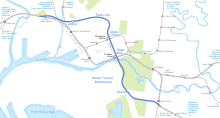
Construction began in 2017 on the Metro Tunnel, a new heavy rail tunnel through the Melbourne central business district designed to relieve congestion on the City Loop tunnels. The 9 km (5.6 mi) dual tunnels are set to open by 2025. The north-south tunnels were first recommended by the Eddington Transport Report in 2008 as a way to increase the central city's rail capacity. The tunnel involves the construction of five new underground stations at Arden, Parkville, State Library, Town Hall and Anzac. There will be direct underground pedestrian interchanges with City Loop and other metropolitan services at State Library with Melbourne Central station, and at Town Hall with Flinders Street station.
This Metro Tunnel will create a new cross-city rail corridor, upgrading and connecting the Pakenham and Cranbourne lines in Melbourne's south-east to the Sunbury line in Melbourne's north-west. Once complete the Cranbourne, Pakenham and Sunbury lines will be taken out of the City Loop, allowing for an increase in services on the Craigieburn and Upfield lines. The Frankston line will be returned to the City Loop and have dedicated use in the Caulfield tunnel, while Sandringham line trains will run through to Williamstown and Werribee via the Flinders Street Viaduct.
Reconfiguration

The Network Development Plan – Metropolitan Rail in 2012 proposed reconfiguring the City Loop. Once complete, the reconfiguration would help the network to run seven independent lines with dedicated access in the CBD. The proposal was again included in the 30-year Infrastructure Strategy for 2021–2051 from the independent government advisory body Infrastructure Victoria, as recommendation 60.
The project would see up to 3 kilometres (1.9 mi) of new tunnel built, creating new entrances to the existing City Loop tunnels. Two of the four City Loop tunnels would be 'split' from the loop, and run as an independent pair of underground cross-city tracks from Richmond station to North Melbourne station. This would allow more trains to pass through the city rather than travelling around the City Loop, and would free up a pair of tracks between Flinders Street station and Southern Cross on the Flinders Street Viaduct for a second cross-city route. According to Infrastructure Victoria, the project would deliver two-thirds of the capacity uplift of the Metro Tunnel for a fraction of the cost.
The main purpose of reconfiguring the City Loop is to allow more services to operate across the network using existing infrastructure. Infrastructure Victoria in its 30-year strategy argued the Craigieburn metropolitan line, the Shepparton regional line and the Seymour regional line would reach capacity in the 2030s, and the City Loop would be heavily congested by 2036. After the Metro Tunnel opens, services would still be constrained by the Craigieburn line sharing a single City Loop track with the Upfield line. Reconfiguration would allow both lines to run more services, and allow more frequent services on the Glen Waverley and Frankston lines.
Infrastructure Victoria envisioned Glen Waverley and Alamein services running through to the Upfield line via the Flinders Street Viaduct and Frankston services running through to the Craigieburn line via the reconfigured City Loop track pair, which differs from the post-reconfiguration network outlined in stage 4 of the 2012 Network Development Plan.
The reconfiguration would also allow for suburban extensions of the rail network, including extending the Upfield line to the northern growth suburbs of Donnybrook, Beveridge and Wallan. Infrastructure Victoria recommended the state government complete a business case into the project.
Layout
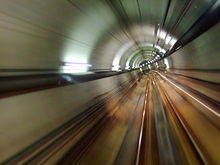
The City Loop consists of four independent single-track tunnels, and services operate as four balloon loops, two of which operate one way during the morning and the other way in the afternoon. The City Loop has four tracks on two levels and all stations have four platforms. The four tunnels have portals on both the eastern and western ends of the city centre. The Burnley and Caulfield tunnels run mostly parallel to each other, beginning at Richmond and ending at Southern Cross. The Clifton Hill tunnel's Western End begins at Southern Cross; the tunnel is the only one that can serve as a full loop, as the tunnel splits into two after Parliament branching off to both Jolimont and Flinders Street.
Services and direction of travel

All metropolitan lines on the Melbourne rail network except for the Stony Point line serve Flinders Street station, but not all of these lines serve the City Loop. Trains on the Frankston line operate to Werribee and Williamstown via Flinders Street while Sandringham services operate directly to Flinders Street in both directions.
The eleven remaining metropolitan lines serve the City Loop and are organised into four separate groups: Burnley, Caulfield, Clifton Hill, and Northern. Each group has its own dedicated single track tunnel, and carries several lines. The Alamein, Belgrave, Craigieburn, Cranbourne, Glen Waverley, Hurstbridge, Lilydale, Mernda, Pakenham, Sunbury, and Upfield lines all run through the loop, although some services run direct to Flinders Street station.
Stopping patterns alternate during weekdays on the Northern and Burnley Groups, with trains switching directions during the day, whereas on the Clifton Hill and Caulfield groups stopping patterns remain consistent all day.
Burnley group
Main articles: Alamein railway line, Belgrave railway line, Glen Waverley railway line, and Lilydale railway lineThe Burnley group consists of the Belgrave, Lilydale, Alamein, and Glen Waverley railway lines. The line is one of two that change operations in the middle of the day. Trains operate anti-clockwise through the loop during weekday mornings and clockwise during weekday afternoons and weekends. Citybound trains from Glen Waverley will not travel via the City Loop on weekday mornings and will instead travel direct to Flinders Street. During the afternoon peak Alamein and Blackburn services run direct to and from Flinders Street, while on weekends all Alamein services terminate at Camberwell and thus do not travel via the City Loop.
Prior to 2011, Glen Waverley trains operated via the City Loop during morning peak, while Alamein and Blackburn services operated direct to Flinders Street.
Caulfield group
Main articles: Cranbourne railway line and Pakenham railway line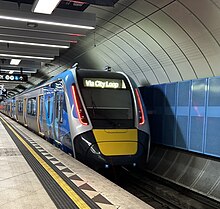
The Caulfield group consists of the Pakenham and Cranbourne lines. The line operates anti-clockwise through the City Loop all day, entering the Loop at Parliament and leaving at Flinders Street.
Major changes were made to the Northern and Caulfield group tunnels in 2021. Previously, the Frankston and Sandringham lines also operated via the Caulfield tunnel. Services also operated clockwise during weekday afternoons while running anti-clockwise during weekday mornings and weekends.
When the Metro Tunnel opens in 2025, Pakenham and Cranbourne services will be pulled out of the loop and instead will operate to Sunbury. Frankston services will return to the loop in the Caulfield group tunnel.
Clifton Hill group
Main articles: Hurstbridge railway line and Mernda railway lineThe Clifton Hill group consists of the Hurstbridge and Mernda lines. The line was the first to operate in a consistent direction all day. All services on the group operate in a clockwise direction all day, entering the city at Flinders Street and leaving after Parliament.
Prior to 2008, services operated anti-clockwise during weekday mornings similar to the Burnley Group. From 2008 to 2013 services ran clockwise on weekdays and anti-clockwise on weekends. The main reason for the current operational direction is because of the flat junction at Jolimont, which prevents inbound trains from running anti-clockwise without crossing the outbound tracks.
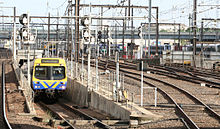
The Clifton Hill tunnel is the only tunnel able to operate as a full loop as the tunnel breaks off towards both Jolimont and Flinders Street after Parliament. Previously this tunnel was used to operate the full time City Circle train line that ran on a permanent loop around the CBD, however in 1993 this service was replaced by the surface-level City Circle tram. The tunnel is still used partially as an alternative form of transport in cases where some lines are temporarily shut down.
Northern group
Main articles: Craigieburn railway line, Sunbury railway line, and Upfield railway lineThe Northern group consists of the Craigieburn, Sunbury, and Upfield lines. Services operate clockwise on weekday mornings and weekends and operate anti-clockwise during weekday afternoons and evenings.
On 31 January 2021, there were major changes to the Northern and Caulfield group tunnels. Prior to this, Werribee services also operated through the loop during weekends, but the line was rerouted to operate to Frankston to increase service reliability on both the Cross-City and Northern groups.
In 2025, Sunbury services will cease operation in the City Loop and will instead connect with the Pakenham and Cranbourne lines via the new Metro Tunnel, allowing greater service frequency on the Craigieburn and Upfield lines.
Summary table
| Platform number | 1 | 2 | 3 | 4 |
|---|---|---|---|---|
| Lines | Clifton Hill group | Caulfield group | Northern group | Burnley group |
| Hurstbridge & Mernda lines | Cranbourne & Pakenham lines | Craigieburn , Sunbury & Upfield lines | Alamein , Belgrave , Glen Waverley & Lilydale lines | |
| Weekday mornings | Clockwise | Anti-clockwise | Clockwise | Anti-clockwise |
| Weekday afternoons | Anti-clockwise | Clockwise | ||
| Weekends | Clockwise | |||
| Notes | In 2025, Cranbourne & Pakenham services will cease operation in the City Loop; Frankston services will re-commence. | In 2025, Sunbury services will cease operation in the City Loop. | Alamein trains only operate via the City Loop on weekdays. |
Stations

The City Loop has three underground railway stations at Parliament, Melbourne Central, and Flagstaff. The stations were opened in the 1980s, with Melbourne Central being the oldest, opening in 1981, and Flagstaff the last to open in 1985. Each railway station features four tracks with two island platforms stacked on top of each other.
Parliament
Main article: Parliament railway stationParliament station opened in 1983 and serves the eastern end of the CBD. The station has entrances on Lonsdale Street and on Macarthur Street. The station gets its name from its proximity to the Parliament of Victoria. The station has interchanges with three tram routes on Nicholson Street and two tram routes on Macarthur Street.
Melbourne Central
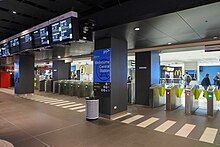
Melbourne Central opened in 1981 as Museum Station. The station received its original name from the Melbourne Museum, which was located within the State Library of Victoria. The station's name was changed in 1997 to Melbourne Central following the 1991 redevelopment of the site above the station to Melbourne Central Shopping Centre and the relocation of the Melbourne Museum to a new building in Carlton Gardens.
Melbourne Central station is unique as it has only one direct street-facing entrance to the station on Elizabeth Street, with a second entrance located inside of the shopping centre. The station interchanges with 15 bus routes on Lonsdale Street, three tram routes on Elizabeth street, eight tram routes on Swanston Street and two tram routes on La Trobe Street.
Flagstaff

Flagstaff station opened in 1985 and serves the Western end of the CBD. The station owes its name because of its proximity to Flagstaff Gardens, which is just north of the station. The station features two entrances on the William/La Trobe street intersection. The station interchanges with two tram routes on Latrobe Street and two tram routes on William Street
References
- ^ S.E. Dornan and R.G. Henderson (1979). Electric Railways of Victoria. Australian Electric Traction Society. p. 92. ISBN 0-909459-06-1.
- ^ C L Fouvy. "The Melbourne Region's Opportunity and need for Rapid Transit" (PDF). Railway Technical Society of Australasia. Archived from the original (PDF) on 21 July 2008. Retrieved 20 July 2008.
- S.E. Dornan and R.G. Henderson (1979). Electric Railways of Victoria. Australian Electric Traction Society. p. 32. ISBN 0-909459-06-1.
- Public Relations and Betterment Board (1950). Operation Phoenix. Victorian Railway Commissioners. (VR publicity brochure)
- Lee, Robert (2007). The Railways of Victoria 1854–2004. Melbourne University Publishing. p. 190. ISBN 978-0-522-85134-2.
- ^ Lee, Robert (2007). The Railways of Victoria 1854–2004. Melbourne University Publishing. p. 191. ISBN 978-0-522-85134-2.
- Melbourne Underground Loop: Construction Work Inaugurated Railway Transportation August 1971 pages 19-22, 36
- Melbourne's underground takes shape Network September 1971 page 1
- ^ S.E. Dornan and R.G. Henderson (1979). Electric Railways of Victoria. Australian Electric Traction Society. p. 93. ISBN 0-909459-06-1.
- The Age 24 May 2010, 'Key role in digging rail loop' Obituary GEOFFREY KEEGAN, AM, ENGINEER, CONSULTANT 20-10-1924 – 22-4-2010
- Australia's Railways. Alison Hideki. 2018. p. 23. ISBN 9781925630763.
- ^ Metropolitan Transport Authority. "MURL Booklet" (PDF). doi.vic.gov.au. Archived from the original (PDF) on 28 June 2009. Retrieved 20 July 2008.
- ^ Department of Infrastructure. "Public transport – City Loop history". doi.vic.gov.au. Archived from the original on 20 May 2009. Retrieved 20 July 2008.
- Off and Running VicRail News March 1981 page 3
- Vincent Adams Winter (1990). VR and VicRail: 1962 – 1983. p. 206. ISBN 0-9592069-3-0.
- Australia, Department of Prime Minister and Cabinet (28 May 1980). "Royal Visit Program, Wednesday 28 May 1980, N 394.40994 ROY". Trove. Retrieved 7 February 2023.
- Melbourne Underground Rail Options Trolley Wire issue 192 February 1981 page 25
- ^ Hui, Jin (24 February 2021). "A new direction for commuters". Berwick Star News. Retrieved 6 February 2023.
- "The biggest timetable change in 40 years". www.metrotrains.com.au. Retrieved 6 February 2023.
- Department of Transport, Victorian (2022). "City Loop upgrade powering ahead".
- ^ Eddie, Rachel (7 May 2022). "City Loop summer standstill could derail recovery, says restaurant group". The Age. Retrieved 28 January 2023.
- "Station Construction Underway On The Metro Tunnel | Premier of Victoria". www.premier.vic.gov.au. Retrieved 18 January 2023.
- Mees, Paul (2010). "Planning for major rail projects: The Melbourne Metro and Regional Rail Link" (PDF). Australasian Transport Research Forum 2010 Proceedings. 29 September – 1 October 2010, Canberra, Australia.
- ^ Build, Victoria's Big (24 October 2022). "Benefits for your train line". Victoria's Big Build: Metro Tunnel. Retrieved 28 January 2023.
- ^ Cowburn, Brodie (7 December 2020). "Rail passengers kept out of the loop". Bayside News. Retrieved 18 January 2023.
- "PTV Network Development Plan Metropolitan Rail Overview" (PDF). Public Transport Victoria. Retrieved 18 December 2012.
- ^ "Victoria's Infrastructure Strategy 2021–2051" (PDF). Infrastructure Victoria. 2021.
- ^ "Reconfiguring the City Loop" (PDF). Infrastructure Victoria.
- "VICSIG". vicsig.net. Retrieved 23 January 2023.
- "VICSIG". vicsig.net. Retrieved 23 January 2023.
- ^ "Victorian Train Network Map" (PDF). Public Transport VictoriA. Retrieved 16 January 2023.
- ^ "Guide to navigating the City Loop | Public Transport Users Association (Victoria, Australia)". Retrieved 14 January 2023.
- "Glen Waverley Line". Public Transport Victoria. Retrieved 14 January 2023.
- "Alamein Line". Public Transport Victoria. Retrieved 14 January 2023.
- "Quick review of the new Metro timetables". Daniel Bowen. 29 March 2011. Retrieved 15 January 2023.
- "280 extra Metro services coming in January". www.metrotrains.com.au. Retrieved 21 January 2023.
- ^ Build, Victoria's Big (13 January 2023). "Metro Tunnel Project". Victoria's Big Build. Retrieved 15 January 2023.
- "Were there more trains 100 years ago? (Part three)". Daniel Bowen. 7 August 2022. Retrieved 15 January 2023.
- "Train timetable changes – first stage effective 27 April 2008 – Metlink – Your guide to public transport in Melbourne and Victoria". 20 July 2008. Archived from the original on 20 July 2008. Retrieved 15 January 2023.
{{cite web}}: CS1 maint: bot: original URL status unknown (link) - "How many trains in peak compared to the past? And how full are the tracks?". Daniel Bowen. 6 April 2015. Retrieved 15 January 2023.
- "VICSIG". vicsig.net. Retrieved 15 January 2023.
- ^ Wong, Marcus (1 August 2022). "Melbourne's mysterious 'City Circle' train". Waking up in Geelong. Retrieved 15 January 2023.
- "Building A Train Network For The Future | Premier of Victoria". www.premier.vic.gov.au. Retrieved 16 January 2023.
- ^ Australia's Railways. Alison Hideki. 2018. p. 21. ISBN 9781925630763.
- "Pedestrian access changes at Parliament Station". www.metrotrains.com.au. Retrieved 18 January 2023.
- ^ Australia's Railways. Alison Hideki. 2018. p. 20. ISBN 9781925630763.
- "Albert St/Nicholson St #10". Public Transport Victoria. Retrieved 18 January 2023.
- "Parliament Railway Station/Macarthur St #10". Public Transport Victoria. Retrieved 18 January 2023.
- "Melbourne Central/Lonsdale St". Public Transport Victoria. Retrieved 18 January 2023.
- "Melbourne Central Station/Elizabeth St #5". Public Transport Victoria. Retrieved 18 January 2023.
- "Melbourne Central Station/Swanston St #8". Public Transport Victoria. Retrieved 18 January 2023.
- "Swanston St/La Trobe St #6". Public Transport Victoria. Retrieved 18 January 2023.
- "What year did your railway station open? | Public Transport Users Association (Victoria, Australia)". 3 August 2018. Retrieved 16 January 2023.
- "Flagstaff Railway Station/William St #7". Public Transport Victoria. Retrieved 21 January 2023.
- "William St/La Trobe St #3". Public Transport Victoria. Retrieved 21 January 2023.
External links
- Public Transport Victoria
- Zen and the City Loop (a more detailed explanation of the five train direction configurations)
- Department of Transport – City Loop history and photo page
- Railpage – Publicity leaflets circa 1970
- Metro Trains Melbourne website
| |||||||||||||||||||
| |||||||||||||||||||
| |||||||||||||||||||
| |||||||||||||||||||
| |||||||||||||||||||